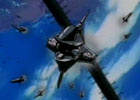Banner of the Stars
| Seikai no Senki | ||
| Also Known As: Battleflag of the Stars, BotS | ||
| Genre: Action/Drama | ||
| Format: 13 Episodes | ||
| Allegiance: Sunrise/WOWOW/Bandai Visual | ||
| Director: Nagaoka Yasuchika | ||
| Vintage: 2000 | ||
| Intelligence Agency Report by: Kuzu Ryu Sen | ||
| Three years have passed since the invasion of Abh territory by the forces of United Mankind. Jinto and Lafiel are once again reunited aboard the destroyer Basrogrh, as Wing Flyer and Deco-Commander respectively. Just as they are finishing their training, the Abh High Command launches Operation “Phantom Flame” in order to reclaim territories lost to the United Mankind three years ago. Immediately sent to the front, Jinto and Lafiel are caught in an intergalactic conflict together once again. However, this time they will be front line soldiers, responsible not only for themselves, but for the lives of others as well. | ||
|
|
||
| Field Agent Report by: Kuzu Ryu Sen | ||
| Plot Characters Impact Visual Audio |
8.50 8.50 9.50 8.75 8.25 |
|
| Overall | 9.00 | |
| (not an average) | ||
The sequel to Crest of the Stars shifts gears, choosing to focus on the larger picture rather than just the story of Jinto and Lafiel. However, very little, if any of the old magic is lost, and Banner of the Starsproves to be a very worthy successor to Crest of the Stars.
The main difference between Crest of the Stars and Banner of the Stars is that Banner chooses to expand the plot tremendously, focusing much more on the strategic elements of the entire war than its predecessor. As a result, the story takes on much more of an epic feel, enhancing the mood and feel of the series. Furthermore, because of the broadening of the plot, a plethora of new characters are introduced, ranging from Jinto’s crewmates aboard the Basrogrh to the Admirals of the Abh Star Forces. The wide majority of these characters are a very welcome addition to the cast, especially some of the Admirals, who unfortunately did not get very much screen time in Crest. Lastly, with the majority of new characters being Abh, the viewer is able to learn much more about Abh culture, and the structure and workings of the Abh military. The climax of this series is a military tactician’s dream.
However, the change in focus brings with it one unavoidable flaw, and that is a lack of character development. With such a diverse cast, and only thirteen episodes, there is very little character development outside of Jinto’s crewmates. Even among the crew, there is only mild character development at best, and this extends to Jinto and Lafiel themselves. From an overall standpoint, because Banner is much less character driven than Crest was, the negative impact is softened somewhat.
Banner of the Stars is a very good series, not only for its epic plot, but for the amount of insight it provides into the very unique world of the Abh. It serves as a very nice bridge between Crest of the Starsand Banner of the Stars II as well, but as a result, should not be watched without prior knowledge of Crest. Ironically, while everything in this show should provide ample incentive to view the sequel, the main incentive is the answer to a certain question that was actually not included.




